Use Python to convert photos into anime-style avatars.

Recently I encountered a problem. I needed to transform my avatar into anime style. My first thought at that time was to find ready-made wheels.

▲Convert pictures to pixel style
Converting avatars to anime style is to convert real photos into real photos while maintaining the original image information and texture details. Convert to anime/cartoon style non-photorealistic image. At present, in addition to Baidu API, there are many open source libraries on Github that we can use directly.
Among them, AnimeGAN is a research from Wuhan University and Hubei University of Technology. It uses a combination of neural style transfer and generative adversarial network (GAN). The effect is very consistent with our needs.

#AnimeGAN first used the Tensorflow framework, but after querying the information, it was found that the project already supports the PyTorch framework.
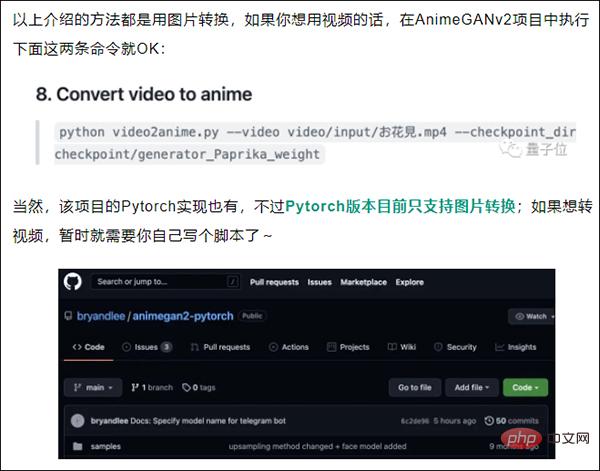
Address: https://github.com/bryandlee/animegan2-pytorch
And I happened to have implemented Weibo comment sentiment analysis based on PyTorch before. So it won’t be a burden to use, and you don’t have to install libraries.
Pytorch installation
PyTorch is an open source Python machine learning library based on Torch for applications such as natural language processing. This deep learning framework can be applied in many directions such as numerical modeling, image modeling, text modeling, audio modeling, etc.

Installing Pytorch will be more troublesome than other libraries. If you go to the official installation and download, you need to get the installation command that suits you based on the actual configuration.
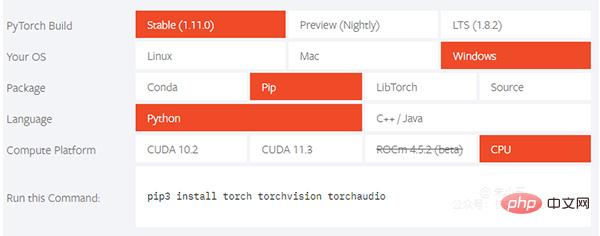
If you find that the download speed is slow or you encounter various problems through the above steps, you might as well try the following website:
https:/ /download.pytorch.org/whl/torch_stable.html
Website view:
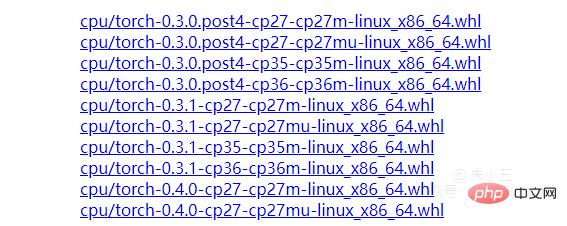
Anime style migration
After installing the Pytorch framework, We can clone the animegan2-pytorch project locally/download it directly:
git clone https://github.com/bryandlee/animegan2-pytorch
Download to the local directory at the end of the article as shown below:
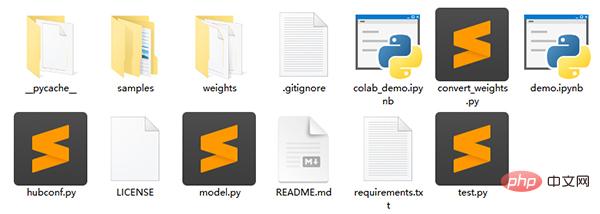
The weights folder contains four weights. Select the corresponding weight to achieve the animation style migration you want. Picture examples are stored in the inputs folder under samples, which can be used directly to test the waters. In addition, I also created a new output folder under the same path to store the processed images.
Next, we only need to run the test.py script in the command line to call the project. The specific command format is as follows:
python test.py --checkpoint [model file path] --input_dir [directory where the input image is located] --output_dir [output directory] --device [device selection, cpu or cuda]
Actual operation:
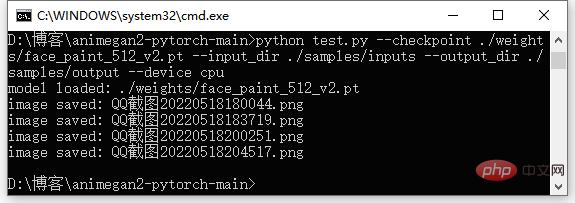
Since it is like realizing face animation migration, I used the weights of face_paint_512_v1.pt and face_paint_512_v2.pt respectively. The effect is as shown in the figure below:
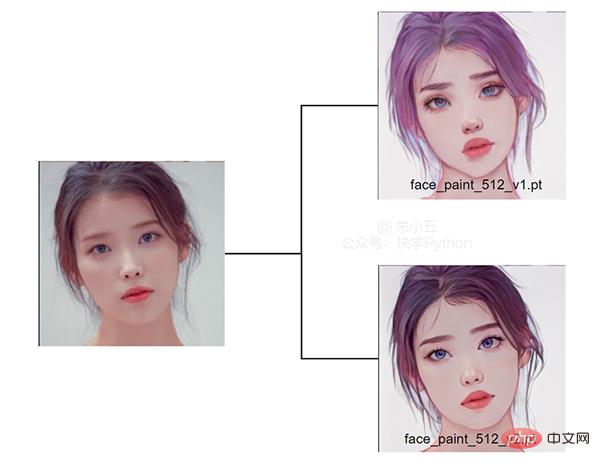
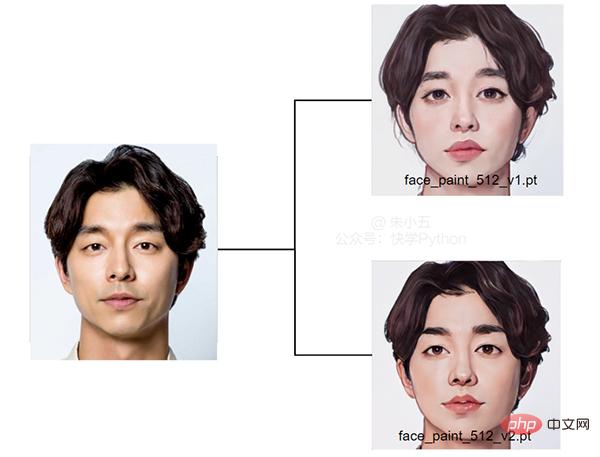 ##Actual effect②
##Actual effect②
Personally, I feel that the finished product with the weight of face_paint_512_v2.pt is more in line with my animation style What do you think of the imagination?
Finally, I also tried paprika.pt to migrate landscape pictures to animation.
 ▲Original picture
▲Original picture
The effect is as shown below:

▲Rendering
If you are interested in converting avatars/pictures into anime style, you might as well give it a try~
Attention!
Notice!
What if after reading this article, you don’t want to install Pytorch, but want to directly create your own comic face?
You can open this URL on your computer: https://huggingface.co/spaces/akhaliq/AnimeGANv2. This is an online AnimeGANv2 APP. You can convert it directly without installing any framework locally.

▲AnimeGANv2 website
The above is the detailed content of Use Python to convert photos into anime-style avatars.. For more information, please follow other related articles on the PHP Chinese website!

Hot AI Tools

Undresser.AI Undress
AI-powered app for creating realistic nude photos

AI Clothes Remover
Online AI tool for removing clothes from photos.

Undress AI Tool
Undress images for free

Clothoff.io
AI clothes remover

AI Hentai Generator
Generate AI Hentai for free.

Hot Article

Hot Tools

Notepad++7.3.1
Easy-to-use and free code editor

SublimeText3 Chinese version
Chinese version, very easy to use

Zend Studio 13.0.1
Powerful PHP integrated development environment

Dreamweaver CS6
Visual web development tools

SublimeText3 Mac version
God-level code editing software (SublimeText3)

Hot Topics
 1378
1378
 52
52
 HadiDB: A lightweight, horizontally scalable database in Python
Apr 08, 2025 pm 06:12 PM
HadiDB: A lightweight, horizontally scalable database in Python
Apr 08, 2025 pm 06:12 PM
HadiDB: A lightweight, high-level scalable Python database HadiDB (hadidb) is a lightweight database written in Python, with a high level of scalability. Install HadiDB using pip installation: pipinstallhadidb User Management Create user: createuser() method to create a new user. The authentication() method authenticates the user's identity. fromhadidb.operationimportuseruser_obj=user("admin","admin")user_obj.
 Navicat's method to view MongoDB database password
Apr 08, 2025 pm 09:39 PM
Navicat's method to view MongoDB database password
Apr 08, 2025 pm 09:39 PM
It is impossible to view MongoDB password directly through Navicat because it is stored as hash values. How to retrieve lost passwords: 1. Reset passwords; 2. Check configuration files (may contain hash values); 3. Check codes (may hardcode passwords).
 The 2-Hour Python Plan: A Realistic Approach
Apr 11, 2025 am 12:04 AM
The 2-Hour Python Plan: A Realistic Approach
Apr 11, 2025 am 12:04 AM
You can learn basic programming concepts and skills of Python within 2 hours. 1. Learn variables and data types, 2. Master control flow (conditional statements and loops), 3. Understand the definition and use of functions, 4. Quickly get started with Python programming through simple examples and code snippets.
 Python: Exploring Its Primary Applications
Apr 10, 2025 am 09:41 AM
Python: Exploring Its Primary Applications
Apr 10, 2025 am 09:41 AM
Python is widely used in the fields of web development, data science, machine learning, automation and scripting. 1) In web development, Django and Flask frameworks simplify the development process. 2) In the fields of data science and machine learning, NumPy, Pandas, Scikit-learn and TensorFlow libraries provide strong support. 3) In terms of automation and scripting, Python is suitable for tasks such as automated testing and system management.
 How to optimize MySQL performance for high-load applications?
Apr 08, 2025 pm 06:03 PM
How to optimize MySQL performance for high-load applications?
Apr 08, 2025 pm 06:03 PM
MySQL database performance optimization guide In resource-intensive applications, MySQL database plays a crucial role and is responsible for managing massive transactions. However, as the scale of application expands, database performance bottlenecks often become a constraint. This article will explore a series of effective MySQL performance optimization strategies to ensure that your application remains efficient and responsive under high loads. We will combine actual cases to explain in-depth key technologies such as indexing, query optimization, database design and caching. 1. Database architecture design and optimized database architecture is the cornerstone of MySQL performance optimization. Here are some core principles: Selecting the right data type and selecting the smallest data type that meets the needs can not only save storage space, but also improve data processing speed.
 How to use AWS Glue crawler with Amazon Athena
Apr 09, 2025 pm 03:09 PM
How to use AWS Glue crawler with Amazon Athena
Apr 09, 2025 pm 03:09 PM
As a data professional, you need to process large amounts of data from various sources. This can pose challenges to data management and analysis. Fortunately, two AWS services can help: AWS Glue and Amazon Athena.
 How to start the server with redis
Apr 10, 2025 pm 08:12 PM
How to start the server with redis
Apr 10, 2025 pm 08:12 PM
The steps to start a Redis server include: Install Redis according to the operating system. Start the Redis service via redis-server (Linux/macOS) or redis-server.exe (Windows). Use the redis-cli ping (Linux/macOS) or redis-cli.exe ping (Windows) command to check the service status. Use a Redis client, such as redis-cli, Python, or Node.js, to access the server.
 How to read redis queue
Apr 10, 2025 pm 10:12 PM
How to read redis queue
Apr 10, 2025 pm 10:12 PM
To read a queue from Redis, you need to get the queue name, read the elements using the LPOP command, and process the empty queue. The specific steps are as follows: Get the queue name: name it with the prefix of "queue:" such as "queue:my-queue". Use the LPOP command: Eject the element from the head of the queue and return its value, such as LPOP queue:my-queue. Processing empty queues: If the queue is empty, LPOP returns nil, and you can check whether the queue exists before reading the element.




